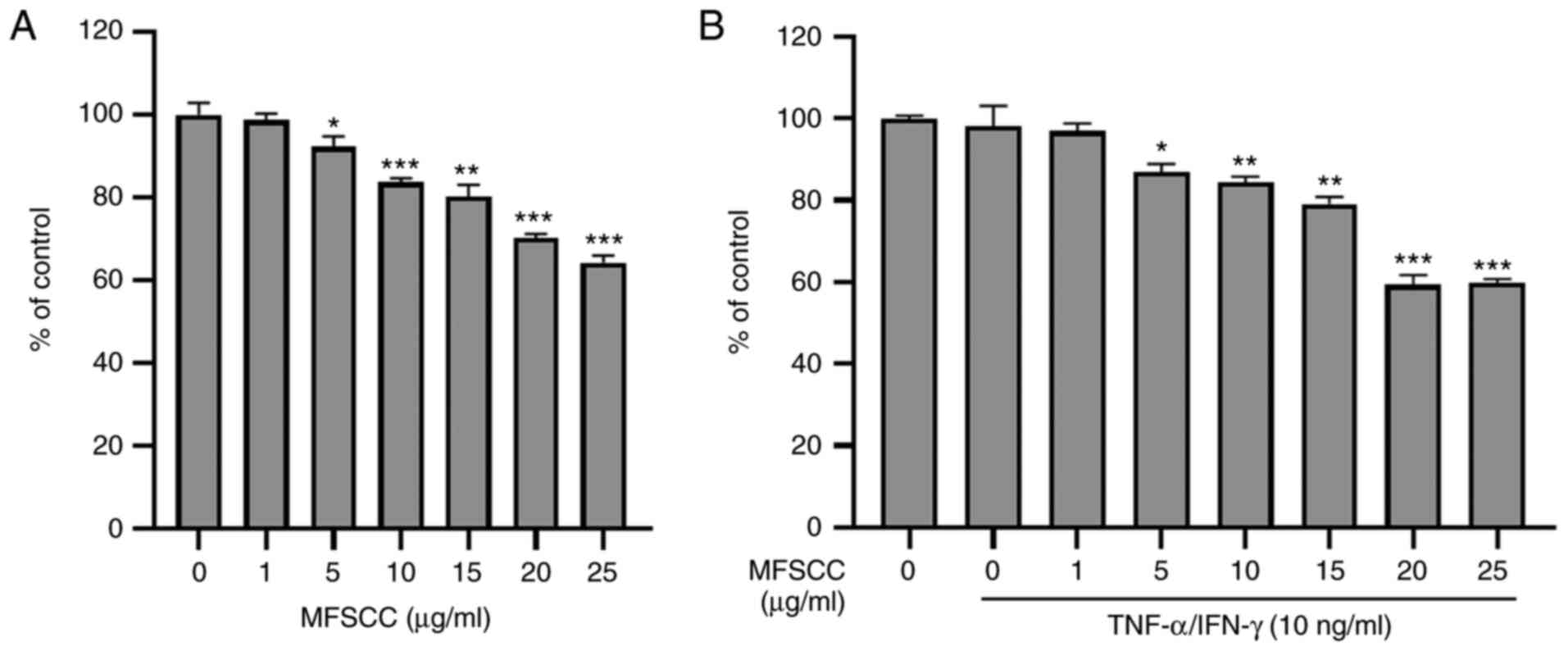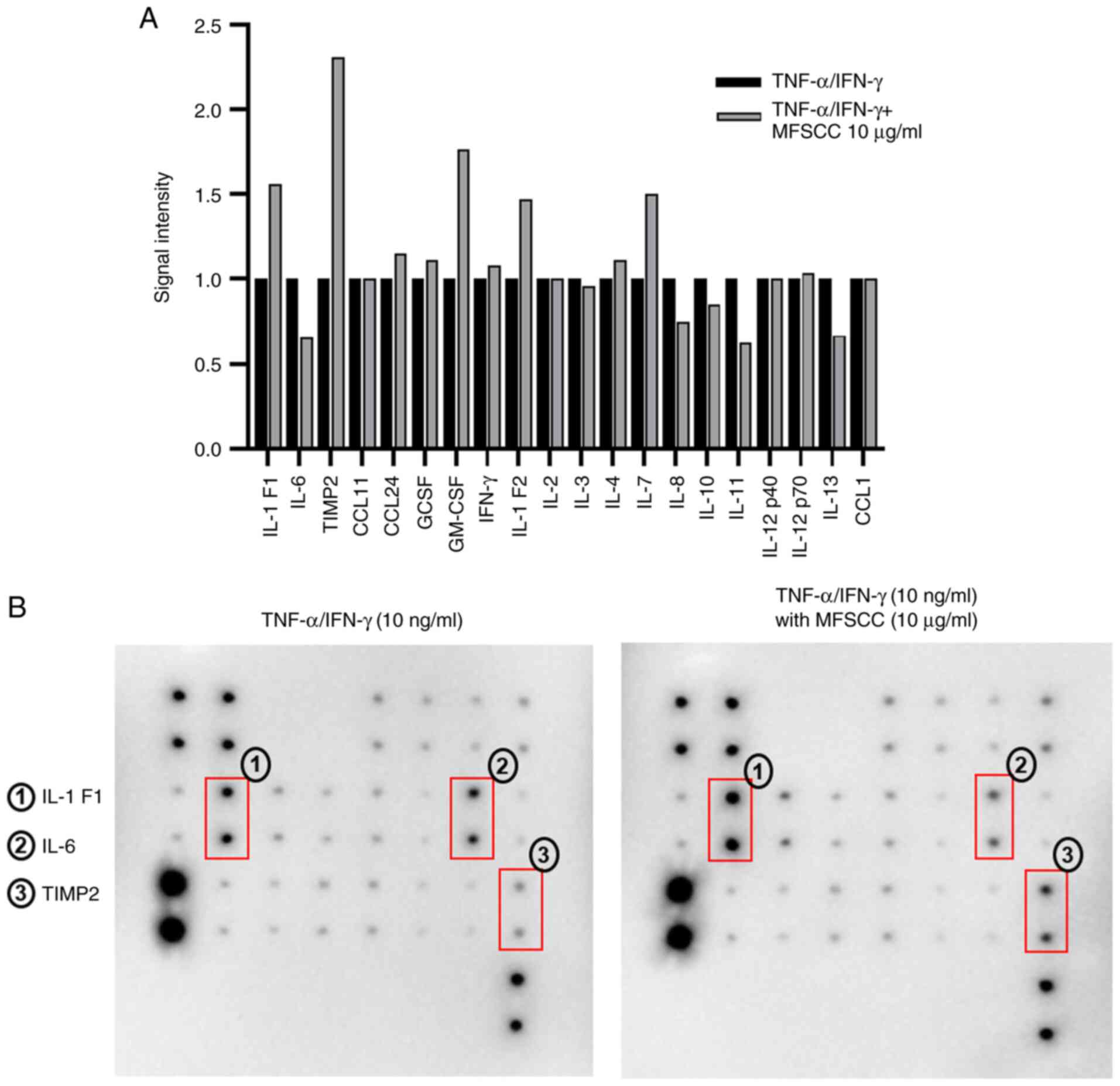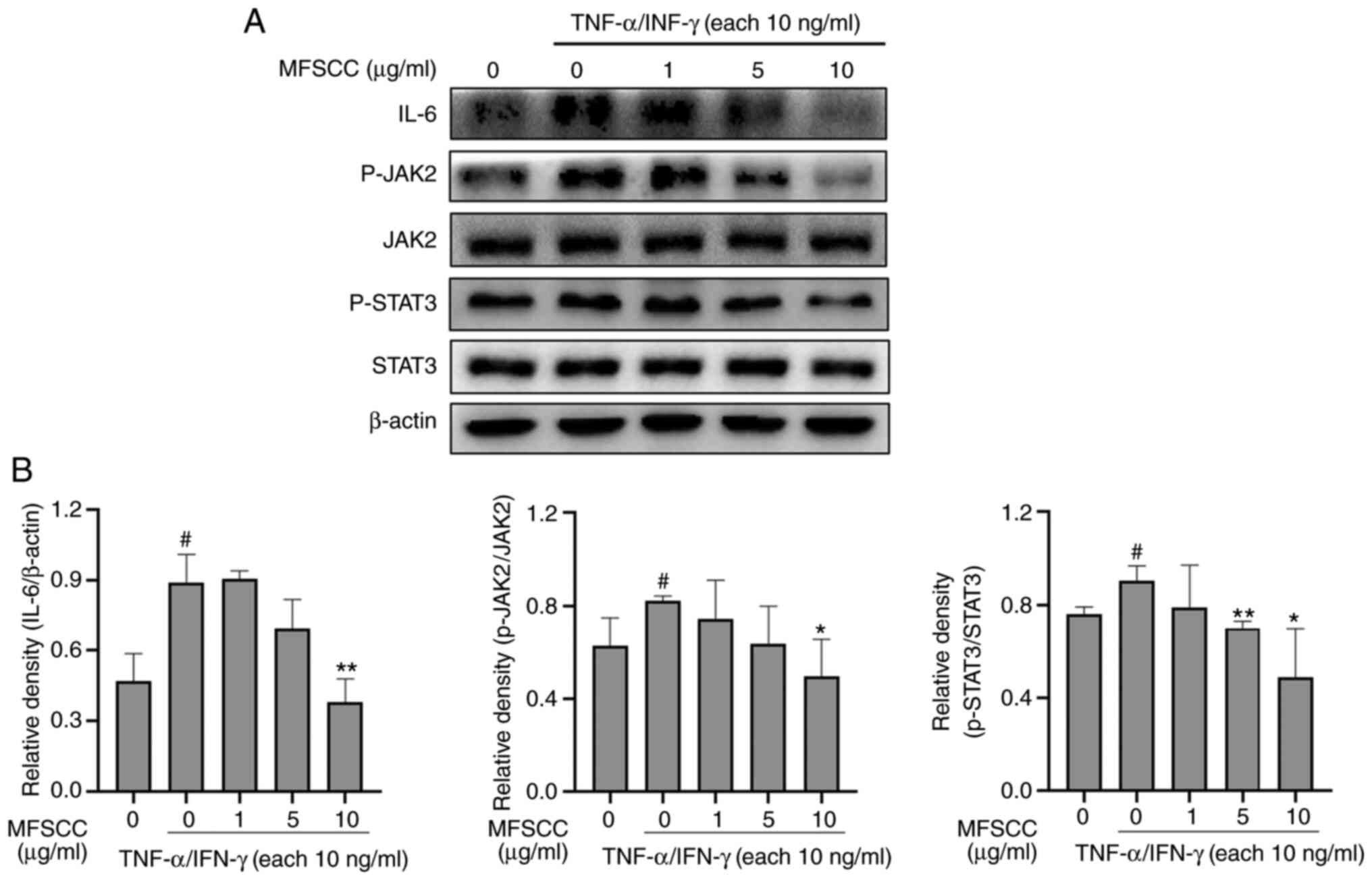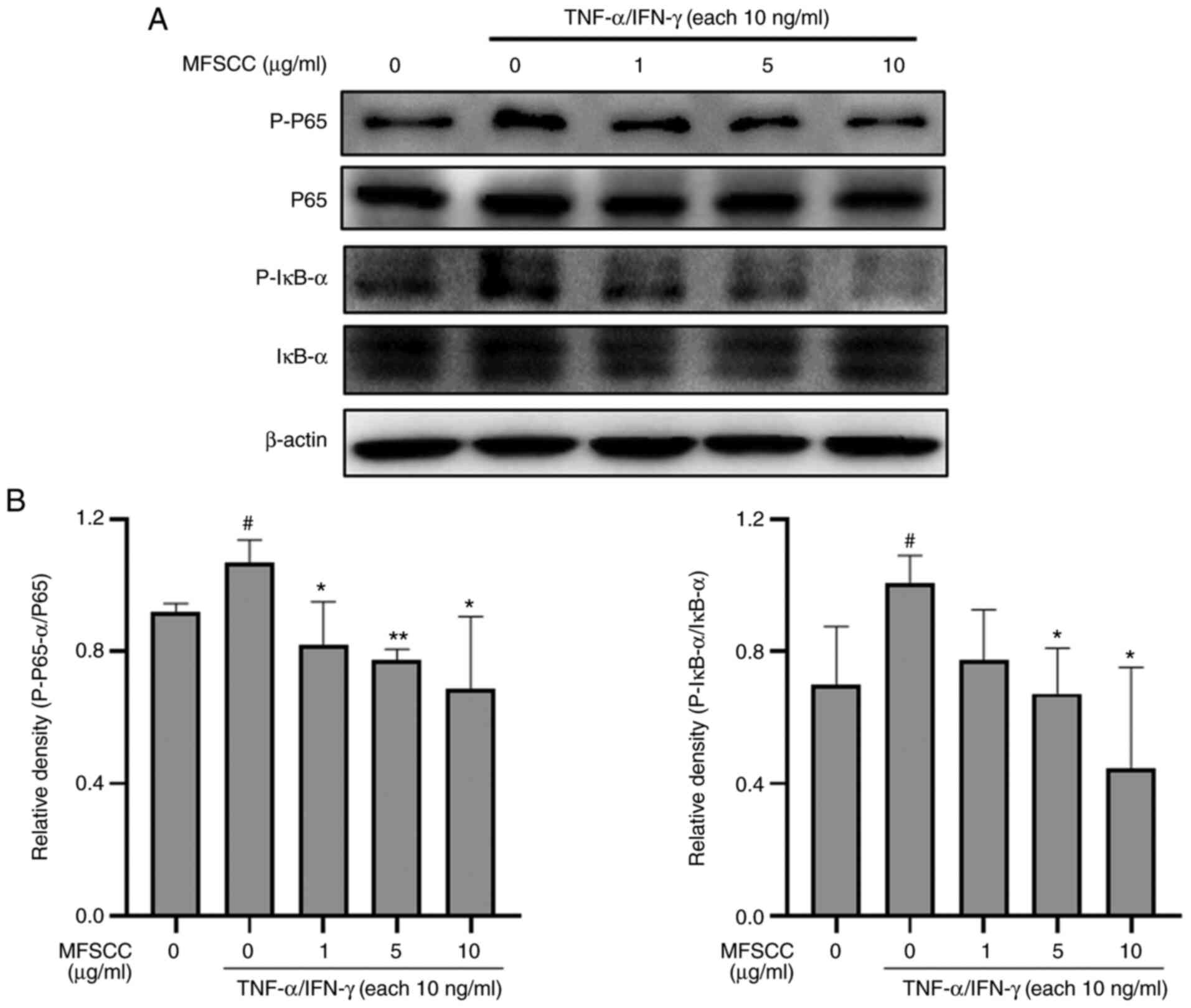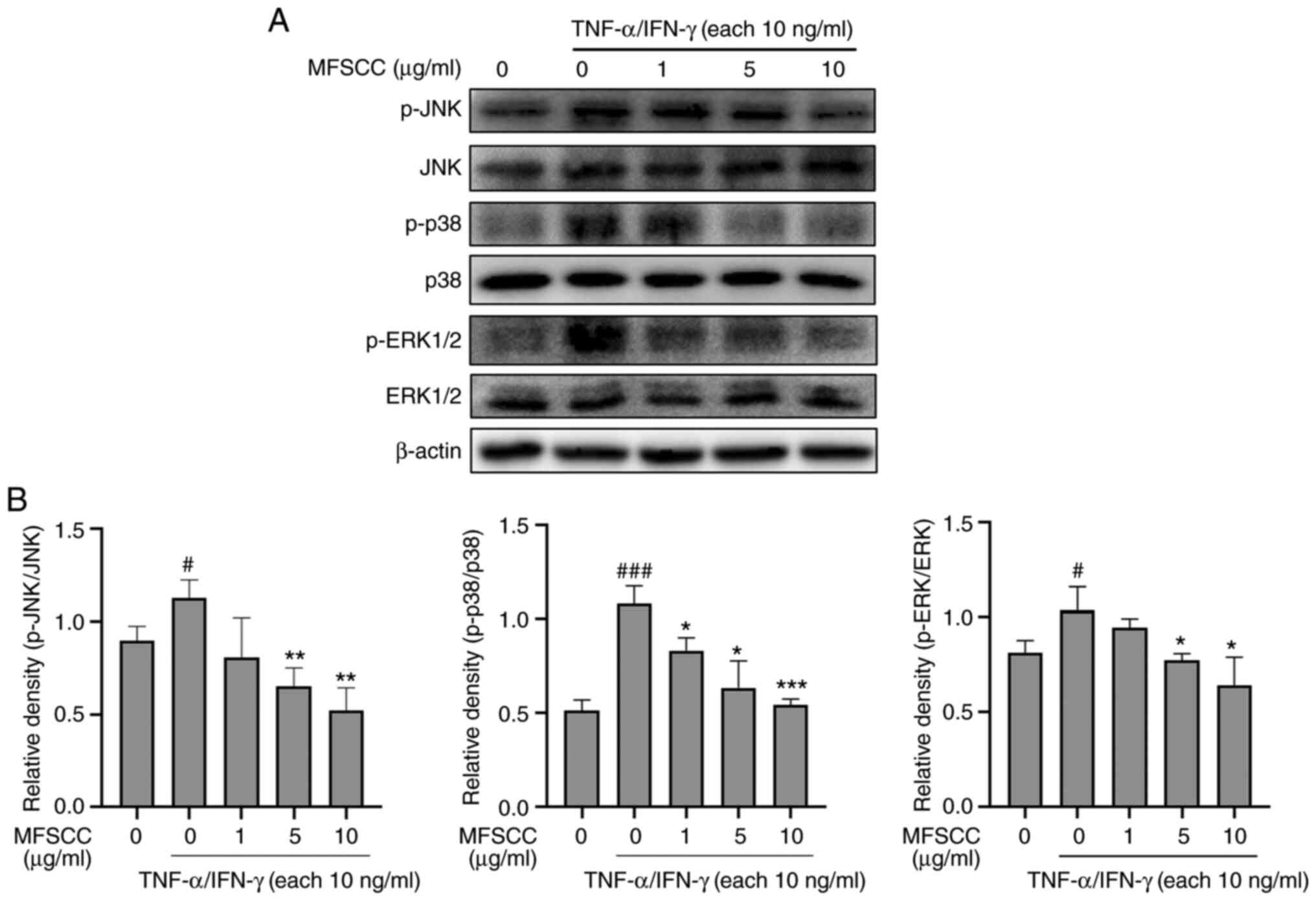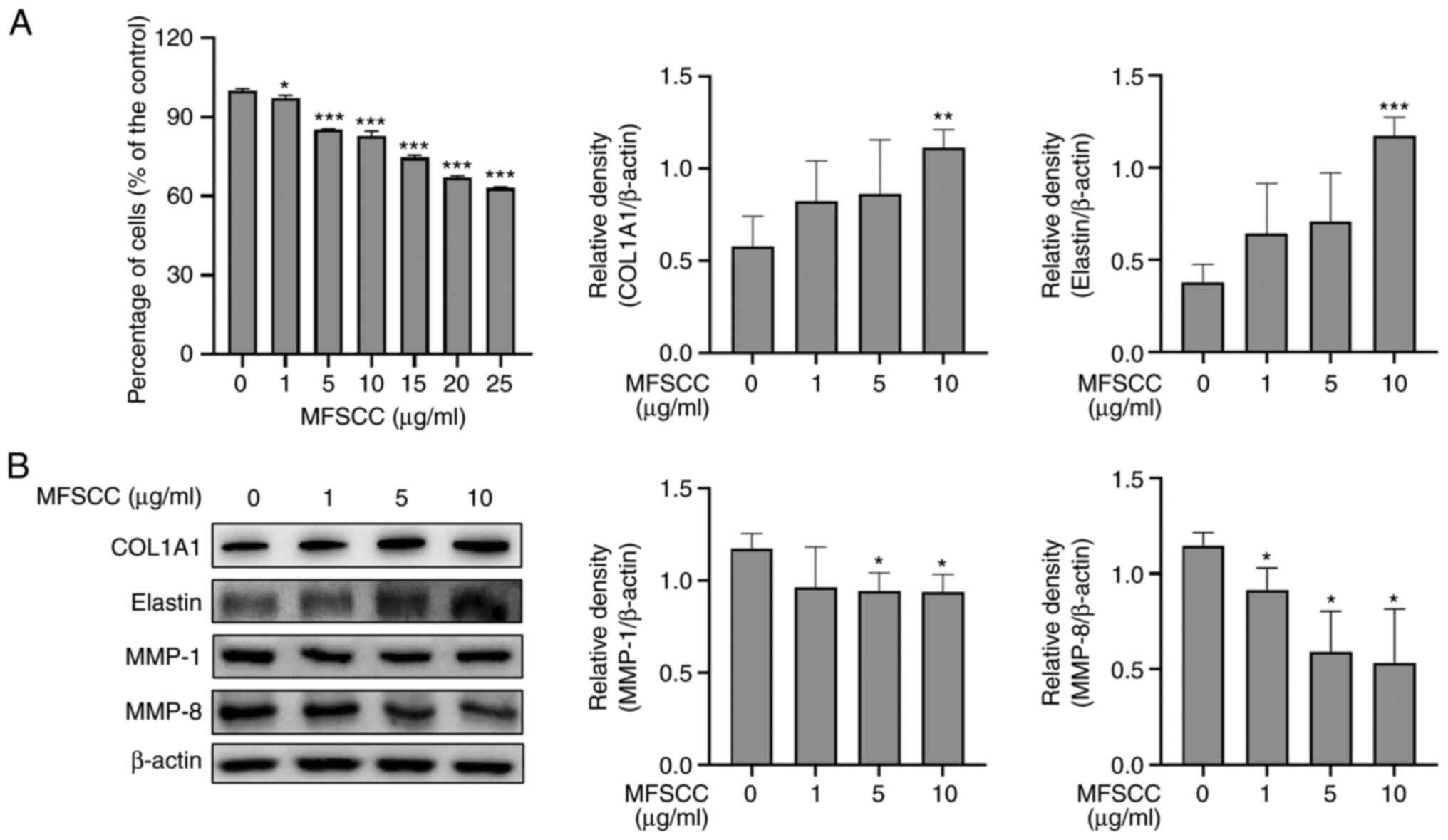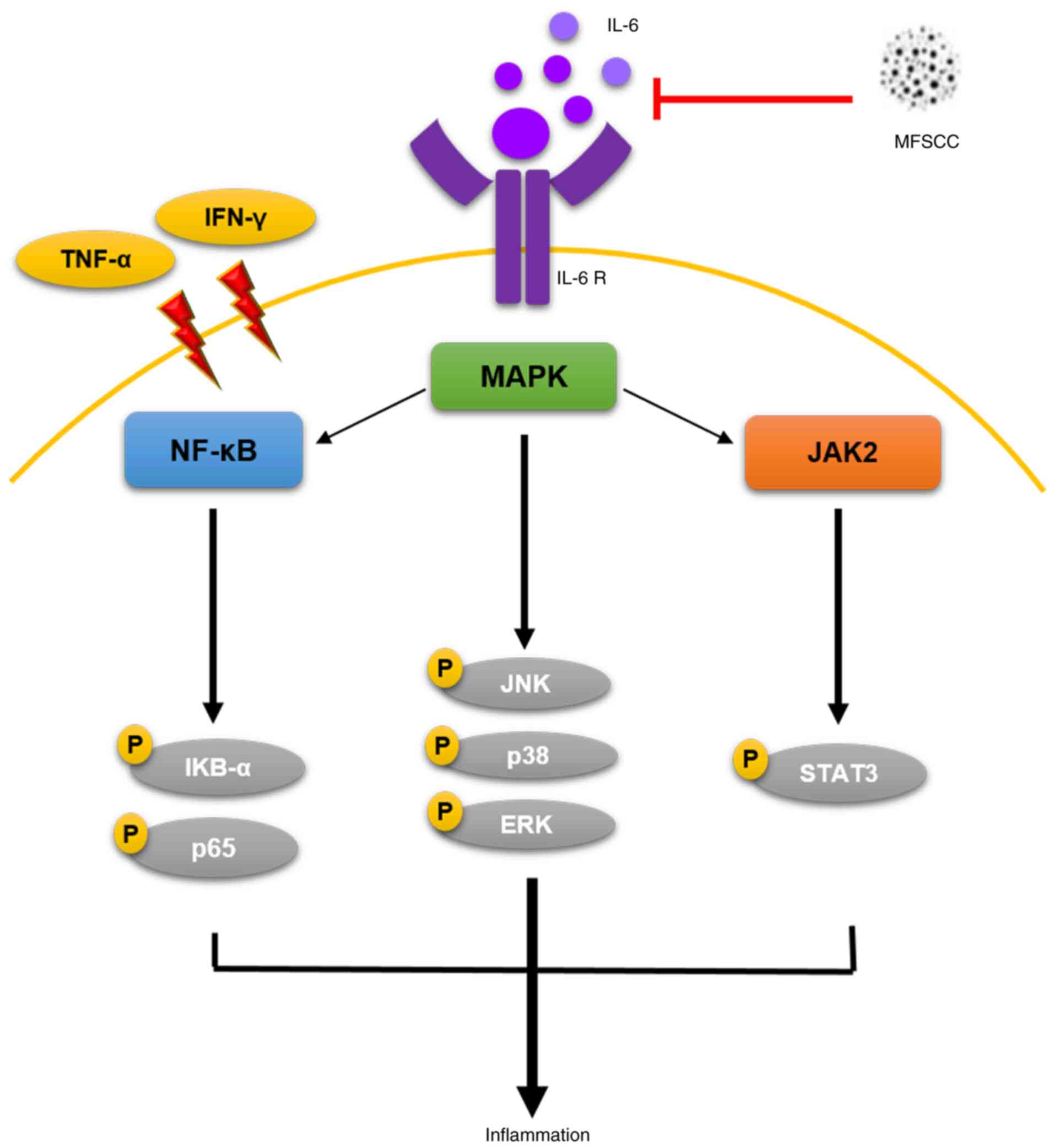|
1
|
Pasparakis M, Haase I and Nestle FO:
Mechanisms regulating skin immunity and inflammation. Nat Rev
Immunol. 14:289–301. 2014. View
Article : Google Scholar : PubMed/NCBI
|
|
2
|
Sabat R, Wolk K, Loyal L, Docke WD and
Ghoreschi K: T cell pathology in skin inflammation. Semin
Immunopathol. 41:359–377. 2019. View Article : Google Scholar : PubMed/NCBI
|
|
3
|
Parisi R, Webb RT, Kleyn CE, Carr MJ,
Kapur N, Griffiths CEM and Ashcroft DM: Psychiatric morbidity and
suicidal behaviour in psoriasis: A primary care cohort study. Br J
Dermatol. 180:108–115. 2019. View Article : Google Scholar : PubMed/NCBI
|
|
4
|
Weidinger S and Novak N: Atopic
dermatitis. Lancet. 387:1109–1122. 2016. View Article : Google Scholar : PubMed/NCBI
|
|
5
|
Wittmann M and Werfel T: Interaction of
keratinocytes with infiltrating lymphocytes in allergic eczematous
skin diseases. Curr Opin Allergy Clin Immunol. 6:329–334. 2006.
View Article : Google Scholar : PubMed/NCBI
|
|
6
|
Miodovnik M, Koren R, Ziv E and Ravid A:
The inflammatory response of keratinocytes and its modulation by
vitamin D: The role of MAPK signaling pathways. J Cell Physiol.
227:2175–2183. 2012. View Article : Google Scholar : PubMed/NCBI
|
|
7
|
Park JH, Kim MS, Jeong GS and Yoon J:
Xanthii fructus extract inhibits TNF-α/IFN-γ-induced Th2-chemokines
production via blockade of NF-κB, STAT1 and p38-MAPK activation in
human epidermal keratinocytes. J Ethnopharmacol. 171:85–93. 2015.
View Article : Google Scholar : PubMed/NCBI
|
|
8
|
Hunter CA and Jones SA: IL-6 as a keystone
cytokine in health and disease. Nat Immunol. 16:448–457. 2015.
View Article : Google Scholar : PubMed/NCBI
|
|
9
|
Johnson DE, O'Keefe RA and Grandis JR:
Targeting the IL-6/JAK/STAT3 signalling axis in cancer. Nat Rev
Clin Oncol. 15:234–248. 2018. View Article : Google Scholar : PubMed/NCBI
|
|
10
|
Ju SM, Song HY, Lee SJ, Seo WY, Sin DH,
Goh AR, Kang YH, Kang IJ, Won MH, Yi JS, et al: Suppression of
thymus- and activation-regulated chemokine (TARC/CCL17) production
by 1,2,3,4,6-penta-O-galloyl-beta-D-glucose via blockade of
NF-kappaB and STAT1 activation in the HaCaT cells. Biochem Biophys
Res Commun. 387:115–120. 2009. View Article : Google Scholar : PubMed/NCBI
|
|
11
|
Liu T, Zhang L, Joo D and Sun SC: NF-κB
signaling in inflammation. Signal Transduct Target Ther.
2:170232017. View Article : Google Scholar : PubMed/NCBI
|
|
12
|
Mussbacher M, Salzmann M, Brostjan C,
Hoesel B, Schoergenhofer C, Datler H, Hohensinner P, Basílio J,
Petzelbauer P, Assinger A and Schmid JA: Cell Type-specific roles
of NF-κB linking inflammation and thrombosis. Front Immunol.
10:852019. View Article : Google Scholar : PubMed/NCBI
|
|
13
|
You P, Fu S, Yu K, Xia Y, Wu H, Yang Y, Ma
C, Liu D, Chen X, Wang J, et al: Scutellarin suppresses
neuroinflammation via the inhibition of the AKT/NF-κB and p38/JNK
pathway in LPS-induced BV-2 microglial cells. Naunyn Schmiedebergs
Arch Pharmacol. 391:743–751. 2018. View Article : Google Scholar : PubMed/NCBI
|
|
14
|
Zhang W and Liu HT: MAPK signal pathways
in the regulation of cell proliferation in mammalian cells. Cell
Res. 12:9–18. 2002. View Article : Google Scholar : PubMed/NCBI
|
|
15
|
Cargnello M and Roux PP: Activation and
function of the MAPKs and their substrates, the MAPK-activated
protein kinases. Microbiol Mol Biol Rev. 75:50–83. 2011. View Article : Google Scholar : PubMed/NCBI
|
|
16
|
Kaminska B: MAPK signalling pathways as
molecular targets for anti-inflammatory therapy - from molecular
mechanisms to therapeutic benefits. Biochim Biophys Acta.
1754:253–262. 2005. View Article : Google Scholar : PubMed/NCBI
|
|
17
|
Bianchi J and Cameron J: Assessment of
skin integrity in the elderly 1. Br J Community Nurs. 13 (Suppl
1):S26S28S30–S32. 2008. View Article : Google Scholar : PubMed/NCBI
|
|
18
|
Zuk PA, Zhu M, Ashjian P, De Ugarte DA,
Huang JI, Mizuno H, Alfonso ZC, Fraser JK, Benhaim P and Hedrick
MH: Human adipose tissue is a source of multipotent stem cells. Mol
Biol Cell. 13:4279–4295. 2002. View Article : Google Scholar : PubMed/NCBI
|
|
19
|
Chen S, He Z and Xu J: Application of
adipose-derived stem cells in photoaging: Basic science and
literature review. Stem Cell Res Ther. 11:4912020. View Article : Google Scholar : PubMed/NCBI
|
|
20
|
Venkatarame Gowda Saralamma V, Vetrivel P,
Kim SM, Ha SE, Lee HJ, Lee SJ, Kim YS, Pak JE, Lee HJ, Heo JD and
Kim GS: Proteome profiling of membrane-free stem cell components by
Nano-LS/MS analysis and its anti-inflammatory activity. Evid Based
Complement Alternat Med. 2019:46832722019. View Article : Google Scholar : PubMed/NCBI
|
|
21
|
Kim KH, Jo JH, Cho HJ, Park TS and Kim TM:
Therapeutic potential of stem cell-derived extracellular vesicles
in osteoarthritis: Preclinical study findings. Lab Anim Res.
36:102020. View Article : Google Scholar : PubMed/NCBI
|
|
22
|
Carlson NG, Wieggel WA, Chen J, Bacchi A,
Rogers SW and Gahring LC: Inflammatory cytokines IL-1 alpha, IL-1
beta, IL-6, and TNF-alpha impart neuroprotection to an excitotoxin
through distinct pathways. J Immunol. 163:3963–3968.
1999.PubMed/NCBI
|
|
23
|
Lambert E, Dassé E, Haye B and Petitfrère
E: TIMPs as multifacial proteins. Crit Rev Oncol Hematol.
49:187–198. 2004. View Article : Google Scholar : PubMed/NCBI
|
|
24
|
Kim SM, Ha SE, Vetrivel P, Kim HH, Bhosale
PB, Park JE, Heo JD, Kim YS and Kim GS: Cellular function of
Annexin A1 protein mimetic peptide Ac2-26 in human skin
keratinocytes HaCaT and fibroblast detroit 551 cells. Nutrients.
12:32612020. View Article : Google Scholar : PubMed/NCBI
|
|
25
|
Ren Q, Guo F, Tao S, Huang R, Ma L and Fu
P: Flavonoid fisetin alleviates kidney inflammation and apoptosis
via inhibiting Src-mediated NF-κB p65 and MAPK signaling pathways
in septic AKI mice. Biomed Pharmacother. 122:1097722020. View Article : Google Scholar : PubMed/NCBI
|
|
26
|
Seif F, Khoshmirsafa M, Aazami H,
Mohsenzadegan M, Sedighi G and Bahar M: The role of JAK-STAT
signaling pathway and its regulators in the fate of T helper cells.
Cell Commun Signal. 15:232017. View Article : Google Scholar : PubMed/NCBI
|
|
27
|
Yoo J, Park K, Yoo Y, Kim J, Yang H and
Shin Y: Effects of egg shell membrane hydrolysates on
anti-inflammatory, anti-wrinkle, anti-microbial activity and
moisture-protection. Korean J Food Sci Anim Resour. 34:26–32. 2014.
View Article : Google Scholar : PubMed/NCBI
|
|
28
|
Hwang E, Park SY, Jo H, Lee DG, Kim HT,
Kim YM, Yin CS and Yi TH: Efficacy and safety of enzyme-modified
panax ginseng for anti-wrinkle therapy in healthy skin: A
single-center, randomized, double-blind, placebo-controlled study.
Rejuvenation Res. 18:449–457. 2015. View Article : Google Scholar : PubMed/NCBI
|
|
29
|
Archer NK, Jo JH, Lee SK, Kim D, Smith B,
Ortines RV, Wang Y, Marchitto MC, Ravipati A, Cai SS, et al:
Injury, dysbiosis, and filaggrin deficiency drive skin inflammation
through keratinocyte IL-1 α release. J Allergy Clin Immunol.
143:1426–1443.e6. 2019. View Article : Google Scholar : PubMed/NCBI
|
|
30
|
Kennedy-Crispin M, Billick E, Mitsui H,
Gulati N, Fujita H, Gilleaudeau P, Sullivan-Whalen M, Johnson-Huang
LM, Suárez-Fariñas M and Krueger JG: Human keratinocytes' response
to injury upregulates CCL20 and other genes linking innate and
adaptive immunity. J Invest Dermatol. 132:105–113. 2012. View Article : Google Scholar : PubMed/NCBI
|
|
31
|
Albanesi C and Pastore S: Pathobiology of
chronic inflammatory skin diseases: Interplay between keratinocytes
and immune cells as a target for anti-inflammatory drugs. Curr Drug
Metab. 11:210–227. 2010. View Article : Google Scholar : PubMed/NCBI
|
|
32
|
Yang JH, Yoo JM, Cho WK and Ma JY:
Anti-inflammatory effects of Sanguisorbae Radix water extract on
the suppression of mast cell degranulation and STAT-1/Jak-2
activation in BMMCs and HaCaT keratinocytes. BMC Complement Altern
Med. 16:3472016. View Article : Google Scholar : PubMed/NCBI
|
|
33
|
Yang JH, Yoo JM, Lee E, Lee B, Cho WK,
Park KI and Yeul Ma J: Anti-inflammatory effects of Perillae Herba
ethanolic extract against TNF-alpha/IFN-gamma-stimulated human
keratinocyte HaCaT cells. J Ethnopharmacol. 211:217–223. 2018.
View Article : Google Scholar : PubMed/NCBI
|
|
34
|
Albanesi C: Keratinocytes in allergic skin
diseases. Curr Opin Allergy Clin Immunol. 10:452–456. 2010.
View Article : Google Scholar : PubMed/NCBI
|
|
35
|
Ravindran J, Agrawal M, Gupta N and Rao
PV: Alteration of blood brain barrier permeability by T-2 toxin:
Role of MMP-9 and inflammatory cytokines. Toxicology. 280:44–52.
2011. View Article : Google Scholar : PubMed/NCBI
|
|
36
|
Schmidt-Arras D and Rose-John S: IL-6
pathway in the liver: From physiopathology to therapy. J Hepatol.
64:1403–1415. 2016. View Article : Google Scholar : PubMed/NCBI
|
|
37
|
Tanaka T, Narazaki M and Kishimoto T: IL-6
in inflammation, immunity, and disease. Cold Spring Harb Perspect
Biol. 6:a0162952014. View Article : Google Scholar : PubMed/NCBI
|
|
38
|
Cho SO, Lim JW and Kim H: Red ginseng
extract inhibits the expression of MCP-1 and iNOS in Helicobacter
pylori-infected gastric epithelial cells by suppressing the
activation of NADPH oxidase and Jak2/Stat3. J Ethnopharmacol.
150:761–764. 2013. View Article : Google Scholar : PubMed/NCBI
|
|
39
|
Dong C, Davis RJ and Flavell RA: MAP
kinases in the immune response. Annu Rev Immunol. 20:55–72. 2002.
View Article : Google Scholar : PubMed/NCBI
|
|
40
|
Taniguchi K and Karin M: IL-6 and related
cytokines as the critical lynchpins between inflammation and
cancer. Semin Immunol. 26:54–74. 2014. View Article : Google Scholar : PubMed/NCBI
|
|
41
|
Weng L, Zhang H, Li X, Zhan H, Chen F, Han
L, Xu Y and Cao X: Ampelopsin attenuates lipopolysaccharide-induced
inflammatory response through the inhibition of the NF-κB and
JAK2/STAT3 signaling pathways in microglia. Int Immunopharmacol.
44:1–8. 2017. View Article : Google Scholar : PubMed/NCBI
|
|
42
|
Chang X, Luo F, Jiang W, Zhu L, Gao J, He
H, Wei T, Gong S and Yan T: Protective activity of salidroside
against ethanol-induced gastric ulcer via the MAPK/NF-κB pathway in
vivo and in vitro. Int Immunopharmacol. 28:604–615. 2015.
View Article : Google Scholar : PubMed/NCBI
|
|
43
|
Karin M and Ben-Neriah Y: Phosphorylation
meets ubiquitination: The control of NF-[kappa]B activity. Annu Rev
Immunol. 18:621–663. 2000. View Article : Google Scholar : PubMed/NCBI
|
|
44
|
Fan Y, Mao R and Yang J: NF-κB and STAT3
signaling pathways collaboratively link inflammation to cancer.
Protein Cell. 4:176–185. 2013. View Article : Google Scholar : PubMed/NCBI
|
|
45
|
Li L, Chen J, Lin L, Pan G, Zhang S, Chen
H, Zhang M, Xuan Y, Wang Y and You Z: Quzhou Fructus Aurantii
Extract suppresses inflammation via regulation of MAPK, NF-κB, and
AMPK signaling pathway. Sci Rep. 10:15932020. View Article : Google Scholar : PubMed/NCBI
|
|
46
|
Zhang TZ, Yang SH, Yao JF, Du J and Yan
TH: Sangxingtang inhibits the inflammation of LPS-induced acute
lung injury in mice by down-regulating the MAPK/NF-κB pathway. Chin
J Nat Med. 13:889–895. 2015.PubMed/NCBI
|
|
47
|
Castejon ML, Sanchez-Hidalgo M,
Aparicio-Soto M, Gonzalez-Benjumea A, Fernandez-Bolanos JG and
Alarcon-de-la-Lastra C: Olive secoiridoid oleuropein and its
semisynthetic acetyl-derivatives reduce LPS-induced inflammatory
response in murine peritoneal macrophages via JAK-STAT and MAPKs
signaling pathways. J Funct Foods. 58:95–104. 2019. View Article : Google Scholar
|
|
48
|
Plastira I, Bernhart E, Joshi L, Koyani
CN, Strohmaier H, Reicher H, Malle E and Sattler W: MAPK signaling
determines lysophosphatidic acid (LPA)-induced inflammation in
microglia. J Neuroinflammation. 17:1272020. View Article : Google Scholar : PubMed/NCBI
|
|
49
|
Yong HY, Koh MS and Moon A: The p38 MAPK
inhibitors for the treatment of inflammatory diseases and cancer.
Expert Opin Investig Drugs. 18:1893–1905. 2009. View Article : Google Scholar : PubMed/NCBI
|
|
50
|
Imokawa G: Mechanism of UVB-induced
wrinkling of the skin: Paracrine cytokine linkage between
keratinocytes and fibroblasts leading to the stimulation of
elastase. J Investig Dermatol Symp Proc. 14:36–43. 2009. View Article : Google Scholar : PubMed/NCBI
|
|
51
|
Oikarinen A: The aging of skin:
Chronoaging versus photoaging. Photodermatol Photoimmunol Photomed.
7:3–4. 1990.PubMed/NCBI
|
|
52
|
Nissinen LM and Kahari VM: Collagen
turnover in wound repair-a macrophage connection. J Invest
Dermatol. 135:2350–2352. 2015. View Article : Google Scholar : PubMed/NCBI
|
|
53
|
Cole MA, Quan T, Voorhees JJ and Fisher
GJ: Extracellular matrix regulation of fibroblast function:
redefining our perspective on skin aging. J Cell Commun Signal.
12:35–43. 2018. View Article : Google Scholar : PubMed/NCBI
|















